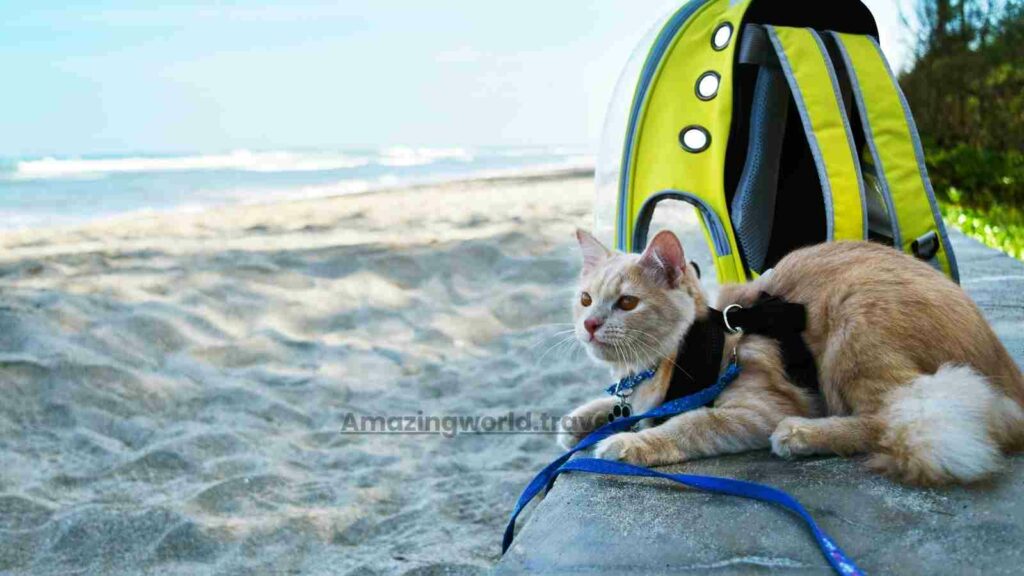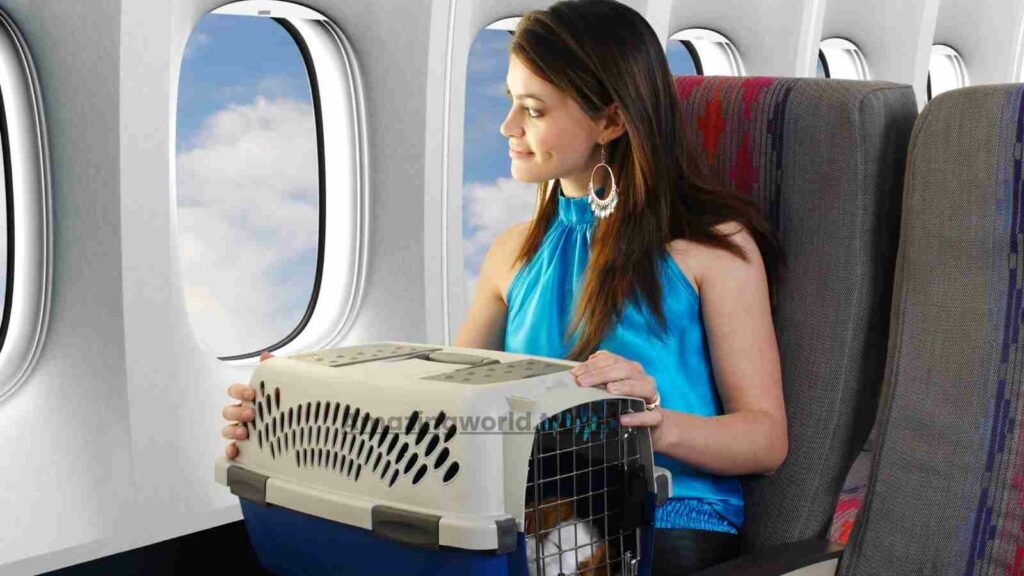Travel With Pets: Your Guide to Flying or Driving

Are you a pet parent seeking the perfect adventure with your feline friend? If you’re passionate about exploring the world with your cat by your side, you’ve come to the right place!
In this guide, we’ll whisk you away on a journey filled with tips and tricks for traveling with your beloved cat. Whether you’re planning a road trip, contemplating air travel, or considering an international escapade, we’ve got you covered.
Get ready to embark on an awesome adventure with your furry companion as we unveil the secrets to stress-free and memorable cat-friendly travel. So, pack your bags, grab your kitty, and let’s uncover the wonders of exploring the world together!
Chapter 1: Preparing for the Journey

Traveling with your beloved pet can be an exciting adventure, but it’s essential to ensure their safety, comfort, and well-being throughout the journey. Here, we’ll delve into the crucial steps to take when preparing for your trip with your furry friend.
Assess Your Pet’s Health
Before embarking on any travel adventure, whether it’s a short road trip or a long flight, it’s imperative to assess your pet’s health. Here’s why this step is so vital:
- Veterinary Check-Up: Schedule an appointment with your veterinarian well in advance of your trip. During the check-up, your vet will examine your pet thoroughly, checking for any underlying health issues that might make travel risky or uncomfortable.
- Vaccinations and Medications: Ensure that your pet’s vaccinations are up-to-date. Depending on your destination, certain vaccinations may be required or recommended. Additionally, discuss any necessary medications with your vet, especially if your pet has specific health concerns.
- Health Certificate: Some airlines and hotels may require a health certificate issued by your veterinarian. This certificate confirms that your pet is fit for travel and has received the necessary vaccinations.
Choose the Right Mode of Transportation
The mode of transportation you choose for your journey plays a significant role in your pet’s comfort and safety. Here’s what you need to consider:
- Distance and Duration: Think about the length of your trip. Is it a short drive, a cross-country road trip, or an international flight? The duration and distance will influence your choice of transportation.
- Pet’s Size: Smaller pets can comfortably travel in a pet carrier in the cabin of an airplane or secured in the car with a pet seat belt. Larger pets may require more spacious accommodations, such as the cargo hold of an aircraft or a larger vehicle.
- Rules and Regulations: Each mode of transportation comes with its own set of rules and regulations regarding pet travel. Familiarize yourself with these guidelines to ensure a smooth journey.
Pack Pet Essentials
To make your pet’s journey as comfortable and stress-free as possible, it’s essential to pack everything they’ll need. Here’s a comprehensive list of pet essentials:
- Food and Water: Bring an ample supply of your pet’s regular food and bottled water. Sudden changes in diet can upset their stomach.
- Medications: Pack any prescribed medications your pet needs, along with clear instructions for administration.
- Bedding: A familiar blanket or bed can provide comfort and a sense of security during travel.
- Toys: Bring your pet’s favorite toys to keep them entertained and reduce anxiety.
- Identification Tags: Ensure your pet wears a collar with up-to-date identification tags that include your contact information.
- First-Aid Kit: Prepare a first-aid kit with essentials like bandages, antiseptic wipes, and tweezers. This kit can be a lifesaver in case of minor injuries.
Chapter 2: Safety on the Road

When you’re hitting the road with your furry companion, their safety should be a top priority. Here’s a detailed look at how to ensure your pet’s safety during car travel.
Secure Your Pet
One of the most critical aspects of pet safety while on the road is ensuring that your pet is properly secured. Here’s why this step is so crucial:
- Harness, Seat Belt, or Carrier: When traveling by car, it’s essential to use a harness, pet seat belt, or a pet carrier to secure your pet. These measures prevent your pet from moving around the vehicle, which can be a significant distraction and a safety hazard. In the event of sudden stops or accidents, securing your pet can save their life.
- Proper Installation: Ensure that you install the harness or seat belt correctly, following the manufacturer’s instructions. The harness should fit snugly but not be too tight or restrictive.
Proper Ventilation
Proper ventilation in the car or pet carrier is essential for your pet’s comfort and well-being. Here’s why you should pay attention to this aspect:
- Overheating Prevention: Adequate airflow helps regulate the temperature inside the vehicle or carrier. Pets can easily overheat, especially in warm weather, so keeping the air flowing is crucial to preventing heat-related issues.
- Reduce Anxiety: Good ventilation can also reduce your pet’s anxiety during the journey. Fresh air and the ability to see their surroundings can help them feel more at ease.
Frequent Breaks
Long road trips can be tiring for both you and your pet. Planning for regular breaks is essential for their comfort and health. Here’s what you need to consider:
- Stretch Their Legs: Pets, especially dogs, need opportunities to stretch their legs and move around. Stopping at rest areas or pet-friendly parks allows your pet to get some exercise and relieve pent-up energy.
- Bathroom Breaks: Just like humans, pets need bathroom breaks. Make sure you stop regularly to let your pet relieve themselves. Always clean up after your pet responsibly to be considerate of others.
- Hydration: Offer your pet water during breaks to keep them well-hydrated, especially during hot weather.
Chapter 3: Air Travel Guidelines

Air travel with your pet can be a convenient way to reach your destination, but it comes with its own set of rules and considerations. Let’s explore these guidelines in detail to ensure a safe and comfortable flight for your furry friend.
Check Airline Policies
Understanding and complying with airline policies is crucial when flying with your pet. Here’s why you should pay close attention to these policies:
- Policy Variations: Different airlines have varying rules and regulations when it comes to pet travel. Some airlines allow pets in the cabin if they meet size and weight requirements, while others may require them to travel in the cargo hold. It’s essential to research and choose an airline that best suits your pet’s needs and your travel plans.
- Size and Weight Restrictions: Airlines typically have size and weight restrictions for pets traveling in the cabin. Small dogs and cats are often allowed, but larger pets may need to travel in the cargo hold. Understanding these restrictions helps you plan accordingly.
Choose the Right Carrier
Selecting the appropriate pet carrier is a crucial step to ensure your pet’s comfort and safety during air travel. Here’s why it matters:
- Well-ventilated and Comfortable: A proper pet carrier should be well-ventilated to provide a continuous flow of fresh air. It should also be comfortable, allowing your pet to lie down, stand, and turn around comfortably. The carrier should provide a sense of security for your pet.
- Labeling: Always label your pet’s carrier with your contact information and your pet’s name. This makes it easy for airline staff to identify your pet and contact you if needed.
- Airline Requirements: Different airlines have specific requirements for pet carriers, such as size and construction materials. Ensure your carrier meets these requirements to avoid any issues at the airport.
Sedation Considerations
Sedation is an option for pets who may experience anxiety or stress during air travel. However, it’s essential to approach sedation with caution and professional guidance:
- Consult Your Veterinarian: Before considering sedation for your pet, consult your veterinarian. They can assess your pet’s health and provide guidance on whether sedation is necessary. Your vet can also prescribe the appropriate sedative and dosage.
- Sedation Risks: Sedating your pet can have risks, especially at high altitudes. Sedation can affect your pet’s respiratory and cardiovascular systems differently during air travel. Only use sedatives as directed by your veterinarian to minimize these risks.
- Monitoring: If your pet is sedated, closely monitor them throughout the journey. Ensure they are responsive and not experience any adverse effects.
Chapter 4: Pet-Friendly Accommodations

When you’re traveling with your furry companion, finding suitable accommodations is essential for a stress-free trip. Here’s an in-depth look at how to navigate pet-friendly accommodations.
Research Pet-Friendly Hotels
Before embarking on your journey, researching and booking pet-friendly accommodations is crucial. Here’s why this step is important:
- Pet Policies: Different hotels have varying pet policies. Some may welcome pets with open arms, while others have specific restrictions or additional fees. Researching these policies in advance helps you avoid surprises upon arrival.
- Availability: Pet-friendly rooms can be limited, especially during peak travel seasons. Booking in advance ensures you secure suitable accommodations for you and your pet.
- Amenities: Some pet-friendly hotels offer extra amenities for your furry friend, such as pet beds or food bowls. Knowing what’s available can enhance your pet’s comfort during the stay.
Prepare Your Pet for the Hotel Stay
Once you’ve booked a pet-friendly hotel, it’s time to prepare your pet for their new environment. Here’s why this preparation is essential:
- Gradual Introduction: Upon arrival at the hotel, introduce your pet to the new surroundings gradually. Allow them to explore the room and become comfortable with the new smells and sounds. Keep a watchful eye on your pet to ensure they feel secure.
- Familiar Items: Bringing familiar items from home, such as their bed, toys, or a blanket, can provide a sense of comfort and familiarity. These items can help reduce your pet’s anxiety in an unfamiliar setting.
- Routine Maintenance: Stick to your pet’s regular feeding and bathroom routines as closely as possible. Consistency can help your pet adjust more smoothly to the hotel stay.
Chapter 5: International Travel

Traveling with your pet internationally adds an extra layer of complexity. To ensure a seamless journey, it’s vital to understand and comply with the entry requirements and regulations of your destination country.
Check Entry Requirements
Researching and understanding the entry requirements of your destination country is crucial for international travel with your pet. Here’s why this step is necessary:
- Vaccinations: Many countries have specific vaccination requirements for incoming pets. Ensure your pet is up-to-date on all necessary vaccinations. Keep records and certificates handy for inspection.
- Microchipping: Some countries may require your pet to be microchipped for identification purposes. Ensure the microchip is registered and functioning correctly.
- Documentation: Prepare all the required documentation, including health certificates and import permits, well in advance. Missing or incomplete paperwork can lead to entry delays or even quarantine.
Quarantine Regulations
Some countries have quarantine regulations for incoming pets to prevent the spread of diseases. Understanding and complying with these regulations is essential to avoid any issues upon arrival:
- Research Quarantine Rules: Check if your destination country has quarantine requirements for pets. If so, familiarize yourself with the duration and conditions of quarantine.
- Prepare for Quarantine: If quarantine is necessary, plan accordingly. Pack essential items like food, medication, and comfort items for your pet to use during their stay in quarantine.
- Compliance: Ensure that your pet meets all health and vaccination requirements to minimize the chances of quarantine. Follow the country’s regulations closely to ensure a smooth entry process.
Conclusion
Before embarking on a journey with your pet, meticulous preparation is essential. Just as you would prepare yourself for a trip, your pet deserves the same level of care and attention. Schedule a thorough vet check-up to confirm your pet’s health status, update vaccinations, and address any potential health concerns. A healthy pet is more likely to enjoy the journey and cope better with the stress of travel. Additionally, creating a checklist of essentials ensures that you won’t forget crucial items like food, water, medications, bedding, and toys, which are vital for your pet’s comfort and well-being during the trip.
How much did you like Our detailed Traveling With Pets: Your Guide to Flying or Driving? Review Also, please share these Blogs with your friends on social media.
Related Article –
- Road Trips Ideas | 12 Tips to Prepare Your Car for a Long Road Trip?
- 150 Best Places to Visit in the United States In 2023
- Road Trip With Kids
- How to Stay Awake While Driving Long Distances
- Audiobooks to Listen to On Your Road Trip
- How to Create an Epic Itinerary Road Trip
- Best Rental Cars For Travel Adventures

Meet David Hoper, a passionate travel Blog writer with 7+ years of experience in travel content. Through his exemplary storytelling and engaging narratives, he shares his experiences and brings destinations to life. With a keen eye for detail and a love for exploration, he has cultivated a diverse portfolio of travel blogs that inspire and inform readers worldwide.








